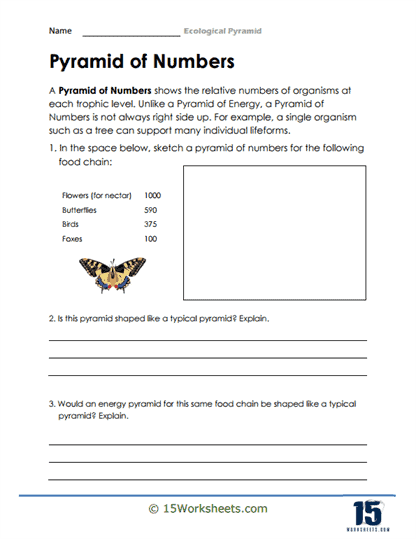Pyramid of Numbers

Worksheet Description
A Pyramid of Numbers shows the relative numbers of organisms at each trophic level. Unlike a Pyramid of Energy, a Pyramid of Numbers is not always right side up. For example, a single organism such as a tree can support many individual lifeforms. You will learn to interpret them on this worksheet.
This worksheet illustrates the relative count of organisms at each trophic level in an ecosystem. Unlike the Pyramid of Energy, the Pyramid of Numbers is not always upright, as certain organisms, like a single tree, can support many individual life forms. Using a specified food chain involving flowers, butterflies, birds, and foxes, students are tasked to sketch a pyramid representing the number of organisms at each level. Furthermore, the worksheet prompts students to contemplate the shape of their created pyramid and compare it with the conventional shape of an energy pyramid.
To effectively engage with this worksheet, students should start by reviewing the provided data for each organism in the food chain. Using these numbers, they should then visualize and sketch the pyramid, ensuring that each trophic level accurately represents the relative count of organisms. After completing the pyramid, students must critically analyze its shape and provide a rationale. This analysis is extended as they are also prompted to theorize how an energy pyramid for the same food chain might appear and the reasons for its shape.
The goal of this worksheet is to deepen students’ understanding of the different ways ecological pyramids can be represented. While energy pyramids often display a diminishing trend from producers to apex predators due to energy loss, the Pyramid of Numbers highlights that the number of organisms doesn’t always follow this pattern. By challenging students to visualize and compare these pyramids, the activity fosters critical thinking and a more nuanced appreciation of ecological interactions. Ultimately, the exercise aims to emphasize the diverse and intricate relationships that exist within ecosystems.
